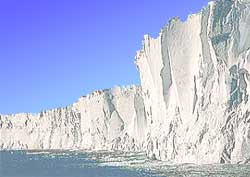Iceberg Calving
 Why the
iceberg calving of
Antarctica is special
Why the
iceberg calving of
Antarctica is specialCalving occurs when a colossal chunk of ice breaks off a thick ice shelf to become an iceberg. This natural phenomenon occurs in both polar regions, but is most awesome on Antarctica.
Iceberg calving tips and insights
Multiple locations
My map below pinpoints one of the foremost iceberg calving regions. However, the spectacle occurs along many Antarctica coasts.
Antarctic vs. Arctic
Iceberg calving is more intense in the Antarctic than in the Artic because its ice shelves (see photo) are significantly higher.
Height
Some Antarctica ice shelves rise 300 meters (1000 feet) above the water.
Danger
A calving iceberg is spectacular to see but can be dangerous because its creates a mini tsunami that's capable of capsizing a nearby boat. There's seldom any warning. When you here the telltale cracking sound, the nascent iceberg has already begun to break off the glacier's face.
What causes iceberg calving?
A glacier calves when there is insufficient ice below the water line of the glacier's facade to support the weight of the corresponding ice above the water line. The undermining is caused by the comparatively warm seawater, which slowly melts the ice it touches.
Recalving
Once calved, an iceberg can calve, too. That's one critical reason you don't want to get too close to an iceberg. The other reason is that an iceberg by nature is unstable. It can suddenly roll over, with its submerged part (which is six times larger than the exposed portion) hitting your boat. If it misses your boat, the huge wave created by the topsy-turvy rotation could swamp your ship or capsize your Zodiac.
Unique
Like fingerprints, no two icebergs are identical. Each has a unique shape.
Location in Antarctica



